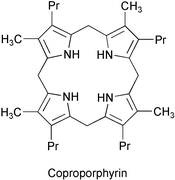ALA induced photodynamic effects on Gram positive and negative bacteria
Abstract
In the present study we examined the production of high amounts of porphyrins upon induction by δ-aminolevulinic acid (ALA) in 9 bacterial strains. This was performed by solely inducing the porphyrin biosynthesis pathway. Four of the strains were Gram positive bacteria and five were Gram negative strains. All strains, except Streptococcus faecalis, produced porphyrins when incubated in PBS with 0.38 mM ALA for 4 h. Excess porphyrin production was excreted to the medium. Gram positive bacteria exhibited fluorescent emission peaks at 622 nm for the endogenous and 617 nm for the excreted porphyrins. Gram negative bacteria exhibited a 630 nm emission peak for the endogenous and a 615 nm emission peak for the excreted extracellular porphyrins. Upon illumination of the ALA induced Staphylococcal strains with 407–420 nm blue light, a decrease of five orders of magnitude was demonstrated with a light dose of 50 J cm−2. Total eradication of the Staphylococcal strains could be achieved with a 100 J cm−2 dose, which resulted in a decrease in viability of seven orders of magnitude. The viability of all the induced Gram negative strains and B. cereus decreased by one or two orders of magnitude upon illumination with 50 and 100 J cm−2, respectively. This difference in the photoinactivation rate was found to be due to the distribution and amounts of the various porphyrins in the bacterial strains. The predominant porphyrin in the Staphylococcal strains was coproporphyrin (68.3–74.6%). In the Gram negative strains there was no predominant porphyrin and the porphyrins found were mostly 5-carboxyporphyrin, uroporphyrin, 7- carboxyporphyrin, coproporphyrin and protoporphyrin. In the B. cereus (Gram positive) strain the predominant porphyrin was uroporphyrin (75.8%). Although the total production of porphyrins in the Gram negative bacteria was higher than in the Staphylococcal strains, the amount of coproporphyrin produced by the latter was twice to three times higher than in the Gram negative strains. The extracellular excreted porphyrins did not contribute to the photoinactivation in any of the tested strains. Significant decreases in the Na+ and K+ content were detected in induced S. aureus after illumination while only small changes were observed in E. coli B. The green fluorescent protein within the cytoplasm of induced E. coli strains was only partially disrupted (by 60% only). These results indicate a partial yield of the effects generated by 1O2 radicals resulting from the photoinactivation of Gram negative bacteria and a successful generation of the same effects in the Staphylococcal strains.

- This article is part of the themed collection: Photosensitized inactivation of microorganisms

 Please wait while we load your content...
Please wait while we load your content...